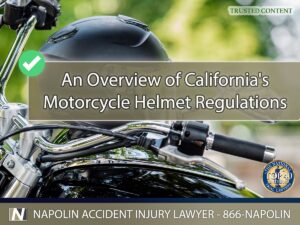An Overview of California’s Motorcycle Helmet Regulations
Motorcycle riders in California face a unique set of risks and responsibilities on the road. One of the most critical aspects of motorcycle safety is the use of helmets. California's motorcycle helmet laws are stringent, reflecting the state's commitment to reducing injuries and fatalities among motorcyclists. Understanding these regulations is essential for all riders to ensure both compliance with the law and personal safety.

California Motorcycle Helmet Laws
California Motorcycle Helmet Laws
California Vehicle Code Section 27802 authorizes the Department of Motor Vehicles (DMV) to establish regulations for motorcycle and motorized bicycle safety helmets. These regulations align with Federal Motor Vehicle Safety Standard No. 218 (49 C.F.R. Sec. 571.218) and require helmets to be conspicuously labeled, indicating compliance with federal safety standards. Additionally, it is illegal to sell or offer for sale any motorcycle or motorized bicycle helmet that does not meet the standards set by the DMV.
Key criteria for a DOT-compliant helmet include:
- Impact Protection: Must limit peak acceleration during impact.
- Penetration Resistance: Must prevent penetration through the helmet.
- Retention System: Straps must stay secure and not stretch more than 1 inch.
- Continuous Surface: Smooth, continuous outer shell without rigid internal projections.
- Peripheral Vision: Must allow clear side vision of at least 105°.
- Labeling: Must include manufacturer details, size, date, and safety warnings.
- DOT Certification: Must have a label with the “DOT” symbol indicating compliance.
- Environmental Durability: Must be tested in various conditions like heat, cold, and water.
- Proper Fit: Must fit the head correctly, as specified by the helmet’s positioning index.
These standards are critical to ensure that every helmet offers the necessary protection that can help save lives and prevent serious injuries in the event of a motorcycle crash. Compliance with these standards is not just a legal requirement but a critical component of road safety for motorcycle riders. By mandating the use of DOT-certified helmets, California's law aligns with the best practices to safeguard its citizens on the roads.
Types of Motorcycle Helmets and Their Legal Status
Motorcyclists have various helmet options, but not all are compliant with California law. Understanding the types of helmets and their legal status is essential for ensuring safety and avoiding penalties.
Full-Face Helmets
Full-face helmets are the most comprehensive in terms of protection. They cover the entire head, including the face and chin, and are typically equipped with a visor. These helmets generally meet all DOT standards and are highly recommended for their superior safety features. Full-face helmets offer the best protection against impacts and road debris.
Half Helmets
Half helmets cover only the top portion of the head and do not include a face shield. While they can be DOT-compliant, riders are recommended to wear additional eye protection, such as goggles. Despite meeting the minimum legal requirements, even DOT-compliant half helmets offer less protection than full-face helmets and are generally not recommended for optimal safety.
Novelty Helmets
Novelty helmets often lack the structural integrity required to meet DOT standards. These helmets may be stylish or lightweight, but they do not provide adequate protection in the event of an accident. Wearing a novelty helmet is not only illegal but also highly dangerous. Riders should avoid these types of helmets entirely.

Steps to Take After a Motorcycle Accident
Steps to Take After a Motorcycle Accident
Experiencing a motorcycle accident can be a traumatic event, and knowing the proper steps to take afterward can significantly affect the outcome of your recovery and legal claims.
Immediate Actions
In the aftermath of an accident, the first priority is to ensure the safety and health of everyone involved. This includes:
- Calling emergency services immediately to report the accident and request medical assistance.
- Seeking medical attention, even if injuries seem minor, as some injuries may not be immediately apparent.
- Moving to a safe location, if possible, to avoid further danger from oncoming traffic.
Legal Steps
After ensuring immediate safety, the next step is to protect your legal rights. This involves:
- Reporting the accident to the police to create an official accident report.
- Documenting the accident scene by taking photographs, noting weather and road conditions, and collecting contact information from witnesses.
- Gathering evidence, such as damaged gear and vehicle parts, which can be crucial in proving fault and the extent of damages.
Importance of Legal Representation
Securing legal representation after a motorcycle accident is crucial for navigating the complex legal landscape. A knowledgeable motorcycle accident attorney can assist in filing claims, negotiating with insurance companies, and pursuing additional compensation if necessary.
Legal Recourse After a Motorcycle Accident in California
Motorcycle accidents can result in severe injuries, and understanding the legal recourse available is crucial for victims. The process involves several steps to ensure proper compensation for damages incurred.
Filing an Insurance Claim
The first step after a motorcycle accident is to file a claim with the at-fault driver’s insurance company. California law requires all drivers to carry liability insurance, which covers damages caused in an accident. Victims should gather all necessary documentation, including the police report, medical records, and evidence from the accident scene, to support their claim.
Personal Injury Lawsuit
If the insurance claim does not cover all the damages, victims may need to file a personal injury lawsuit. This legal action seeks compensation beyond what the insurance policy offers, covering medical expenses, lost wages, and pain and suffering. An experienced attorney can guide victims through this complex process, ensuring that all legal requirements are met and that the best possible outcome is achieved.
Role of an Attorney
Having legal representation is invaluable in motorcycle accident cases. Attorneys provide expertise in negotiating with insurance companies and navigating the legal system. They work to maximize the compensation for victims, taking into account all aspects of the accident and its impact on the victim's life. Legal counsel can also help identify all liable parties, ensuring a comprehensive approach to recovery.

An Overview of California's Motorcycle Helmet Regulations
An Overview of California's Motorcycle Helmet Regulations
Understanding and complying with California's motorcycle helmet laws is essential for the safety and legal protection of all riders. These laws are designed to minimize injuries and fatalities, and adherence to them reflects a rider's commitment to responsible riding. For those who have been involved in a motorcycle accident, seeking legal assistance is crucial for navigating the aftermath and securing the compensation needed for recovery.
Napolin Accident Injury Lawyer has extensive experience in handling motorcycle accident cases. Our dedicated team is committed to helping injury victims understand their rights and achieve the best possible outcomes. If you or a loved one has been injured in a motorcycle accident, do not hesitate to seek the legal support you deserve.
Contact Napolin Accident Injury Lawyer today at (909) 962-8415 for a free consultation near the Inland Empire. Our expertise and dedication to client success make us a trusted choice for those seeking justice and fair compensation. Let us help you navigate the complexities of your case and secure the recovery you need to move forward.
